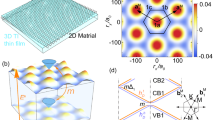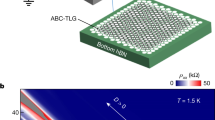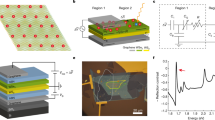Abstract
Electron correlation and topology are two central threads of modern condensed matter physics. Semiconductor moiré materials provide a highly tuneable platform for studies of electron correlation1,2,3,4,5,6,7,8,9,10,11,12. Correlation-driven phenomena, including the Mott insulator2,3,4,5, generalized Wigner crystals2,6,9, stripe phases10 and continuous Mott transition11,12, have been demonstrated. However, non-trivial band topology has remained unclear. Here we report the observation of a quantum anomalous Hall effect in AB-stacked MoTe2 /WSe2 moiré heterobilayers. Unlike in the AA-stacked heterobilayers11, an out-of-plane electric field not only controls the bandwidth but also the band topology by intertwining moiré bands centred at different layers. At half band filling, corresponding to one particle per moiré unit cell, we observe quantized Hall resistance, h/e2 (with h and e denoting the Planck’s constant and electron charge, respectively), and vanishing longitudinal resistance at zero magnetic field. The electric-field-induced topological phase transition from a Mott insulator to a quantum anomalous Hall insulator precedes an insulator-to-metal transition. Contrary to most known topological phase transitions13, it is not accompanied by a bulk charge gap closure. Our study paves the way for discovery of emergent phenomena arising from the combined influence of strong correlation and topology in semiconductor moiré materials.
This is a preview of subscription content, access via your institution
Access options
Access Nature and 54 other Nature Portfolio journals
Get Nature+, our best-value online-access subscription
$29.99 / 30 days
cancel any time
Subscribe to this journal
Receive 51 print issues and online access
$199.00 per year
only $3.90 per issue
Buy this article
- Purchase on Springer Link
- Instant access to full article PDF
Prices may be subject to local taxes which are calculated during checkout




Similar content being viewed by others
Data availability
Source data are provided with this paper. All other data are available from the corresponding authors.
References
Wu, F., Lovorn, T., Tutuc, E. & MacDonald, A. H. Hubbard model physics in transition metal dichalcogenide moiré bands. Phys. Rev. Lett. 121, 026402 (2018).
Regan, E. C. et al. Mott and generalized Wigner crystal states in WSe2/WS2 moiré superlattices. Nature 579, 359–363 (2020).
Tang, Y. et al. Simulation of Hubbard model physics in WSe2/WS2 moiré superlattices. Nature 579, 353–358 (2020).
Wang, L. et al. Correlated electronic phases in twisted bilayer transition metal dichalcogenides. Nat. Mater. 19, 861–866 (2020).
Shimazaki, Y. et al. Strongly correlated electrons and hybrid excitons in a moiré heterostructure. Nature 580, 472–477 (2020).
Xu, Y. et al. Correlated insulating states at fractional fillings of moiré superlattices. Nature 587, 214–218 (2020).
Zhang, Y., Yuan, N. F. Q. & Fu, L. Moiré quantum chemistry: charge transfer in transition metal dichalcogenide superlattices. Phys. Rev. B 102, 201115 (2020).
Andrei, E. Y. et al. The marvels of moiré materials. Nat. Rev. Mater. 6, 201–206 (2021).
Huang, X. et al. Correlated insulating states at fractional fillings of the WS2/WSe2 moiré lattice. Nat. Phys. 17, 715–719 (2021).
Jin, C. et al. Stripe phases in WSe2/WS2 moiré superlattices. Nat. Mater. 20, 940–944 (2021).
Li, T. et al. Continuous Mott transition in semiconductor moiré superlattices. Nature 597, 350–354 (2021).
Ghiotto, A. et al. Quantum criticality in twisted transition metal dichalcogenides. Nature 597, 345–349 (2021).
Hasan, M. Z. & Kane, C. L. Colloquium: topological insulators. Rev. Mod. Phys. 82, 3045–3067 (2010).
Andrei, E. Y. & MacDonald, A. H. Graphene bilayers with a twist. Nat. Mater. 19, 1265–1275 (2020).
Balents, L., Dean, C. R., Efetov, D. K. & Young, A. F. Superconductivity and strong correlations in moiré flat bands. Nat. Phys. 16, 725–733 (2020).
Kennes, D. M. et al. Moiré heterostructures as a condensed-matter quantum simulator. Nat. Phys. 17, 155–163 (2021).
Serlin, M. et al. Intrinsic quantized anomalous Hall effect in a moiré heterostructure. Science 367, 900–903 (2020).
Sharpe, A. L. et al. Emergent ferromagnetism near three-quarters filling in twisted bilayer graphene. Science 365, 605–608 (2019).
Chen, G. et al. Tunable correlated Chern insulator and ferromagnetism in a moiré superlattice. Nature 579, 56–61 (2020).
Cao, Y. et al. Unconventional superconductivity in magic-angle graphene superlattices. Nature 556, 43–50 (2018).
Wu, F., Lovorn, T., Tutuc, E., Martin, I. & MacDonald, A. H. Topological insulators in twisted transition metal dichalcogenide homobilayers. Phys. Rev. Lett. 122, 086402 (2019).
Devakul, T., Crépel, V., Zhang, Y. and Fu, L. Magic in twisted transition metal dichalcogenide bilayers. Nat. Commun. https://doi.org/10.1038/s41467-021-27042-9 (2021).
Hohenadler, M. & Assaad, F. F. Correlation effects in two-dimensional topological insulators. J. Phys. Condens. Matter 25, 143201 (2013).
Witczak-Krempa, W., Chen, G., Kim, Y. B. & Balents, L. Correlated quantum phenomena in the strong spin-orbit regime. Annu. Rev. Condens. Matter Phys. 5, 57–82 (2014).
Pesin, D. & Balents, L. Mott physics and band topology in materials with strong spin–orbit interaction. Nat. Phys. 6, 376–381 (2010).
Raghu, S., Qi, X.-L., Honerkamp, C. & Zhang, S.-C. Topological Mott insulators. Phys. Rev. Lett. 100, 156401 (2008).
Zhang, Y., Devakul, T. & Fu, L. Spin-textured Chern bands in AB-stacked transition metal dichalcogenide bilayers. Proc. Natl Acad. Sci. USA 118, e2112673118 (2021).
Chang, C.-Z. et al. Experimental observation of the quantum anomalous Hall effect in a magnetic topological insulator. Science 340, 167–170 (2013).
Kou, X. et al. Scale-invariant quantum anomalous Hall effect in magnetic topological insulators beyond the two-dimensional limit. Phys. Rev. Lett. 113, 137201 (2014).
Mogi, M. et al. Magnetic modulation doping in topological insulators toward higher-temperature quantum anomalous Hall effect. Appl. Phys. Lett. 107, 182401 (2015).
Liu, C.-X., Zhang, S.-C. & Qi, X.-L. The quantum anomalous Hall effect: theory and experiment. Annu. Rev. Condens. Matter Phys. 7, 301–321 (2016).
MacDonald, A. H. Introduction to the physics of the quantum Hall regime. Preprint at arXiv:cond-mat/9410047 (1994).
Young, A. F. et al. Tunable symmetry breaking and helical edge transport in a graphene quantum spin Hall state. Nature 505, 528–532 (2014).
Li, T. et al. Charge-order-enhanced capacitance in semiconductor moiré superlattices. Nat. Nanotechnol. 16, 1068–1072 (2021).
Y. M. Xie, C. P. Zhang, J. X. Hu, K. F. Mak & Law, K. T. Theory of valley polarized quantum anomalous Hall state in moiré MoTe2/WSe2 heterobilayers. Preprint at arXiv:2106.13991 (2021).
Fei, Z. et al. Edge conduction in monolayer WTe2. Nat. Phys. 13, 677–682 (2017).
Amaricci, A., Budich, J. C., Capone, M., Trauzettel, B. & Sangiovanni, G. First-order character and observable signatures of topological quantum phase transitions. Phys. Rev. Lett. 114, 185701 (2015).
Ezawa, M., Tanaka, Y. & Nagaosa, N. Topological phase transition without gap closing. Sci. Rep. 3, 2790 (2013).
Senthil, T. Theory of a continuous Mott transition in two dimensions. Phys. Rev. B 78, 045109 (2008).
Wang, L. et al. One-dimensional electrical contact to a two-dimensional material. Science 342, 614–617 (2013).
Zibrov, A. A. et al. Tunable interacting composite fermion phases in a half-filled bilayer-graphene Landau level. Nature 549, 360–364 (2017).
Ashoori, R. C. et al. Single-electron capacitance spectroscopy of discrete quantum levels. Phys. Rev. Lett. 68, 3088–3091 (1992).
Xie, Y.-M., Zhang, C.-P., Hu, J.-X., Mak, K. F. & Law, K. Theory of valley polarized quantum anomalous Hall state in moiré MoTe2/WSe2 heterobilayers. Preprint at arXiv:2106.13991 (2021).
Perdew, J. P., Burke, K. & Ernzerhof, M. generalized gradient approximation made simple. Phys. Rev. Lett. 77, 3865–3868 (1996).
Peng, H., Yang, Z.-H., Perdew, J. P. & Sun, J. Versatile van der Waals density functional based on a meta-generalized gradient approximation. Phys. Rev. 6, 041005 (2016).
Kresse, G. & Furthmüller, J. Efficiency of ab-initio total energy calculations for metals and semiconductors using a plane-wave basis set. Comput. Mater. Sci. 6, 15–50 (1996).
Liu, G.-B., Xiao, D., Yao, Y., Xu, X. & Yao, W. Electronic structures and theoretical modelling of two-dimensional group-VIB transition metal dichalcogenides. Chem. Soc. Rev. 44, 2643–2663 (2015).
Acknowledgements
This research was primarily supported by the US Department of Energy, Office of Science, Basic Energy Sciences, under award no. DE-SC0019481 (electrical measurements). The experimental study was partially supported by the Cornell Center for Materials Research with funding from the NSF MRSEC program (DMR-1719875) for device fabrication, the Air Force Office of Scientific Research under award number FA9550-19-1-0390 (capacitance measurements) and FA9550-20-1-0219 (optical characterizations), and the US Army Research Office under grant no. W911NF-17-1-0605 (analysis). The theoretical work at Massachusetts Institute of Technology was supported by the Simons Foundation through a Simons Investigator Award (theoretical analysis) and by the US Department of Energy, Office of Science, Basic Energy Sciences, Division of Materials Sciences and Engineering Awards no. DE-SC0020149 (band structure calculation). Growth of the hBN crystals was supported by the Elemental Strategy Initiative of MEXT, Japan and CREST (no. JPMJCR15F3), JST. This work made use of the Cornell NanoScale Facility, an NNCI member supported by NSF Grant no. NNCI-1542081. L.F. is partially supported by the David and Lucile Packard Foundation.
Author information
Authors and Affiliations
Contributions
T.L., S.J., B.S. and L.L. fabricated the devices, performed the measurements and analysed the data. Z.T. provided assistance with the optical characterization. Y.Z. performed the DFT calculations. Y.Z., T.D. and L.F. performed theoretical analysis. K.W. and T.T. grew the bulk hBN crystals. T.L., S.J., J.S. and K.F.M. designed the scientific objectives and oversaw the project. All authors discussed the results and commented on the manuscript.
Corresponding authors
Ethics declarations
Competing interests
The authors declare no competing interests.
Additional information
Peer review information Nature thanks Lede Xian, You Zhou and the other, anonymous, reviewer(s) for their contribution to the peer review of this work. Peer reviewer reports are available.
Publisher’s note Springer Nature remains neutral with regard to jurisdictional claims in published maps and institutional affiliations.
Extended data figures and tables
Extended Data Figure 1 Optical micrograph of device 1.
MoTe2/WSe2 heterobilayer is outlined by the black line. Electrode 1-9 are labeled. For the results presented in the main text, electrode 5 and 6 are grounded; electrode 1 is used as a source electrode. The longitudinal voltage drop is measured between 3 and 4; and the transverse voltage drop is measured between 3 and 8. The scale bar is 10 μm.
Extended Data Figure 2 2D maps in filling factor and electric field.
2D map of \({R}_{{xx}}\) (a), \({R}_{{xy}}\) (b) and \(C/{C}_{g}\) (c) as a function of filling factor and electric field. The data are converted from the 2D maps in Fig. 1c, d and 3d. The QAH region is circled by green dashed lines.
Extended Data Figure 3 Other devices exhibiting the QAH effect at \({\boldsymbol{\nu }}{\boldsymbol{=}}{\bf{1}}\).
a,b, Magnetic-field dependence of \({R}_{{xy}}\) and \({R}_{{xx}}\) from device 2 and 3 at 1.6 K. Quantized Hall resistance at zero magnetic field is observed in device 2; \({R}_{{xx}}\) is not measured. The resistance quantization in device 3 is nearly perfect at a small magnetic field, accompanied by a significant drop in \({R}_{xx}\). c,d, The same as a,b for device 1 measured from different pairs of probes (than the result shown in the main text) at 300 mK. The labeling of the electrodes is shown in Extended Data Fig. 1. Nearly quantized resistance with similar magnetic-field dependence is observed. The coercive field varies slightly from device to device.
Extended Data Figure 4 Temperature and electric-field dependences of \({{\boldsymbol{R}}}_{{\boldsymbol{xx}}}\) and \({{\boldsymbol{R}}}_{{\boldsymbol{xy}}}\) at \({\boldsymbol{\nu }}{\boldsymbol{=}}{\bf{1}}\).
a, Hall resistance at \(\nu =1\) as a function of electric field under both forward and backward scans at 300 mK (device 1). The out-of-plane magnetic field is fixed at 0 or ±0.1 T. No hysteresis is observed. Typical fluctuation of the Hall plateau from the ideal value \(h/{e}^{2}\) is about 5%. b, c, Electric-field dependence of \({R}_{{xx}}\) (b) and \({R}_{{xy}}\) (c) at varying temperatures in the zero-magnetic-field limit. A Hall plateau \({R}_{{xy}}\approx h/{e}^{2}\) in electric field, correlated with a substantial resistance dip \({R}_{{xx}}\ll {R}_{{xy}}\), is observed at low temperatures.
Extended Data Figure 5 Magnetic-field scans of \({{\boldsymbol{R}}}_{{\boldsymbol{xx}}}\) and \({{\boldsymbol{R}}}_{{\boldsymbol{xy}}}\) at \({\boldsymbol{\nu }}={\bf{1}}\).
Magnetic-field dependence of \({R}_{{xy}}\) (a) and \({R}_{{xx}}\) (b) under varying electric fields at 1.6 K. Each curve for \({R}_{{xy}}\) is vertically shifted by 60 kΩ for clarity. No vertical shift is applied to \({R}_{{xx}}\). The green and purple curves are inside the QAH region; they display nearly quantized \({R}_{{xy}}\) and small \({R}_{{xx}}\). A remnant anomalous Hall response (clear magnetic hysteresis but not quantized) is observed near the QAH-metal boundary (yellow curve). A nearly quantized Hall response with large \({R}_{{xx}}\gg {R}_{{xy}}\) is observed near the Mott-QAH boundary (blue curve). It is a quantized Hall insulator. Further away from the boundary and into the Mott region,\({R}_{{xx}}\) diverges rapidly and \({R}_{{xy}}\) diminishes (red and black curves).
Extended Data Figure 6 Charge gap from thermal activation transport.
a, Arrhenius plot of \({R}_{{xx}}\) at varying electric fields for the Mott insulator. The high-temperature data is well described by the thermal activation model (dashed lines), from which the activation gap is extracted. b, Same as a for the QAH insulator. Here thermal activation behavior (dashed line) is observed only at low temperature, when the QAH state develops. The extracted charge gaps are shown as empty red circles (Mott insulator) and filled circle (QAH insulator) in Fig. 3c of the main text.
Extended Data Figure 7 Identification of the QAH region in the capacitance device (device 6).
a–d, Normalized differential top-gate capacitance, \(C/{C}_{g}\), versus magnetic field and filling factor at 300 mK. Results for four different electric fields are shown. Most strongly dispersive incompressible states shown arise from the Landau levels of the graphite top gate and are irrelevant in this study. The black dashed lines, originated from \(\nu =1\), are the theoretical magnetic-field dispersion of a QAH state with Chern number -1. We use this to determine the Mott-QAH insulator boundary in Fig. 3c of the main text. The system is a Mott insulator in a since there is no magnetic field dispersion of the incompressible state; it is near the Mott-QAH insulator boundary in b; and it is a QAH insulator in c, d. The QAH insulator-metal boundary is determined as capacitance reaches \(C/{C}_{g}\approx 1\) in the metallic state. e, Electric-field dependence of \(C/{C}_{g}\) at \(\nu =1\), 300 mK and zero magnetic field. The QAH region determined from a–d is shaded in blue. The normalized capacitance \(C/{C}_{g}\) equals to 1 for a metallic state at large electric fields. It is below 1 for incompressible states, which include both the Mott and QAH insulating states. Charge gap closure (i.e. \(C/{C}_{g}\) = 1) is not observed at the Mott-QAH phase boundary.
Extended Data Figure 8 Kohn-Sham wave functions.
a, Interlayer distance (top) and stacking alignment (bottom) of relaxed AB-stacked MoTe2/WSe2 heterobilayers. MM, MX, and XX (M = Mo or W, X = Se or Te) are the high-symmetry stacking sites. b-d, Real-space wave function at the Γm-point of the MBZ for the flat band (b), the first (c) and second (d) dispersive valence moiré bands. The envelope wave function for the flat band is located at the MX site. The atomic-scale orbitals consist of both the d-orbitals of the M atom and the p-orbitals of the X atom, forming a honeycomb network. The wave functions for the first and second dispersive moiré bands are located at the MM and XX sites, respectively. The atomic-scale orbitals are dominated by the d-orbitals of the M atom, forming a triangular network. The results show that the dispersive bands are originated from the K or K’ valleys of the TMD monolayers.
Extended Data Figure 9 Moiré band structure at varying displacement fields.
Moiré valence band structure of AB-stacked MoTe2/WSe2 heterobilayers from DFT with displacement field 0 V/nm (a), 0.2 V/nm (b), 0.25 V/nm (c) and 0.3 V/nm (d). The first moiré band is shown in red (The two branches are from the different folding scheme of the K and –K valley states, which are degenerate in energy and shifted in momentum); the flat band is in blue; and the rest of the bands are in black. The energy gap at the Km-point (marked by a red circle) between the two dispersive moiré bands closes and reopens between 0.25 V/nm and 0.3 V/nm. The insets in c and d show the envelope wave function at the Km-point of the MBZ for the first (left inset) and second (right inset) dispersive bands. Before gap closure, the Km-point wave function for the two dispersive bands is centered at the MM and XX site, respectively. They are centered at the same sites as the Γm-point wave function (see Extended Data Fig. 8). The envelope wave function switches moiré sites after gap reopening, showing the emergence of topological bands (see Methods for the interaction effects).
Extended Data Figure 10 Magnetoresistance and nonlocal transport at \({\boldsymbol{\nu }}={\bf{2}}\).
a, Magnetoresistance, Rxx(B)/Rxx(B = 0) at 300 mK under an out-of-plane magnetic field at varying electric fields. The effect is much weaker than magnetoresistance under an in-plane magnetic field (Fig. 4c, d of the main text). b, Nonlocal resistance versus filling factor around \(\nu =2\) after gap reopening. The magnetic field is zero. The arrow for I in the inset shows the direction of the bias electric field between the source and drain electrodes. Voltage drops between electrode 3 and 4 (V3-4) and between 7 and 6 (V7-6) are measured. A change in sign for the nonlocal resistance is consistent with the presence of helical edge state transport for a quantum valley-spin Hall insulator.
Supplementary information
Source data
Rights and permissions
About this article
Cite this article
Li, T., Jiang, S., Shen, B. et al. Quantum anomalous Hall effect from intertwined moiré bands. Nature 600, 641–646 (2021). https://doi.org/10.1038/s41586-021-04171-1
Received:
Accepted:
Published:
Issue Date:
DOI: https://doi.org/10.1038/s41586-021-04171-1
This article is cited by
-
Engineering interlayer hybridization in van der Waals bilayers
Nature Reviews Materials (2024)
-
Fractional quantum anomalous Hall effect in multilayer graphene
Nature (2024)
-
Imaging moiré excited states with photocurrent tunnelling microscopy
Nature Materials (2024)
-
Tuning commensurability in twisted van der Waals bilayers
Nature (2024)
-
Optical readout of the chemical potential of two-dimensional electrons
Nature Photonics (2024)
Comments
By submitting a comment you agree to abide by our Terms and Community Guidelines. If you find something abusive or that does not comply with our terms or guidelines please flag it as inappropriate.



